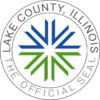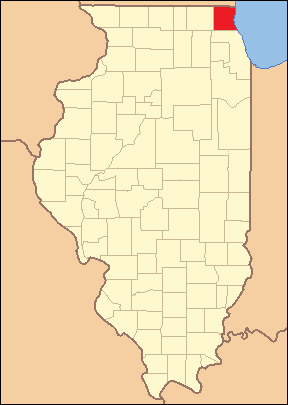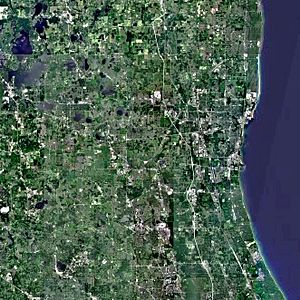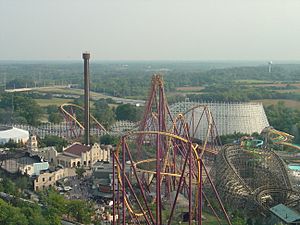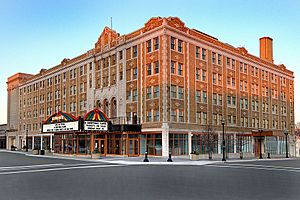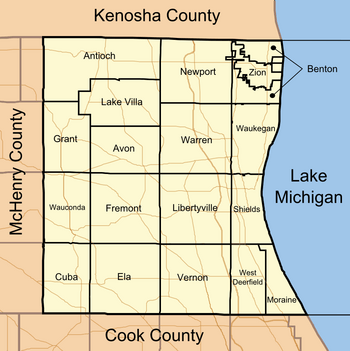Lake County, Illinois facts for kids
Quick facts for kids
Lake County
|
|||||
|---|---|---|---|---|---|
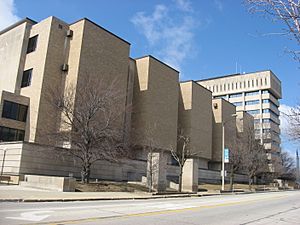
Lake County Courthouse in Waukegan
|
|||||
|
|||||
| Nickname(s):
L.C.
|
|||||
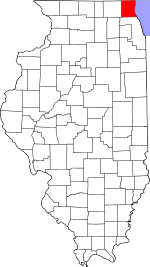
Location within the U.S. state of Illinois
|
|||||
 Illinois's location within the U.S. |
|||||
| Country | |||||
| State | |||||
| Founded | March 1, 1839 | ||||
| Named for | Lake Michigan | ||||
| Seat | Waukegan | ||||
| Largest city | Waukegan | ||||
| Area | |||||
| • Total | 1,368 sq mi (3,540 km2) | ||||
| • Land | 444 sq mi (1,150 km2) | ||||
| • Water | 925 sq mi (2,400 km2) 67.6% | ||||
| Population
(2020)
|
|||||
| • Total | 714,342 | ||||
| • Estimate
(2023)
|
708,760 |
||||
| • Density | 1,596.31/sq mi (616.34/km2) | ||||
| Time zone | UTC−6 (Central) | ||||
| • Summer (DST) | UTC−5 (CDT) | ||||
| Congressional districts | 5th, 9th, 10th, 11th | ||||
Lake County is a county in the northeastern part of Illinois. It sits right along the shores of Lake Michigan. In 2020, about 714,342 people lived here. This makes it the third-largest county in Illinois by population.
The main city and county seat is Waukegan. Lake County has many suburban areas, some city parts, and a few rural spots. It's just north of Cook County, so it's part of the big Chicago metropolitan area. The northern edge of the county touches the Wisconsin state line.
Lake County is known as one of the wealthiest counties in Illinois. Many rich communities like Lake Forest and Highland Park are found here. These areas are often called the "North Shore." While some parts are very wealthy, other areas like Waukegan, North Chicago, and Zion have changed over time. They used to be industrial areas. The number of Hispanic people in the county has grown a lot. In 2020, they made up 24% of the population.
A very important place in the county is Naval Station Great Lakes in North Chicago. This is where the United States Navy trains all its new recruits. It's the only place in the Navy where this happens. Lake County also has a special natural area called Chiwaukee Prairie Illinois Beach Lake Plain. This area includes Illinois Beach State Park and is important for its wetlands.
Contents
History of Lake County
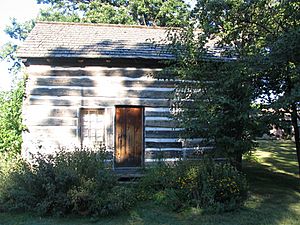
The Illinois State Legislature officially created Lake County in 1839. Back then, most of the county was empty land. Libertyville, which was called Independence Grove, was the first county seat.
In 1841, people in the county voted to move the government to Little Fort. This town is now known as Waukegan. The county leaders bought land there from the state. Lake County's first courthouse was built on this land in 1844. It cost $4,000 to build.
The first courthouse was only for court meetings and a jail. But in 1853, new buildings were made for county offices and records. On October 19, 1875, a fire damaged the courthouse. Luckily, the county records were saved because they were in a different building nearby.
After the fire, some people wanted to move the county seat again. They suggested places like Highland Park or Libertyville. But the county leaders decided to rebuild in Waukegan. The east part of the building was rebuilt for $45,000. Later, a jail was added in 1895. More additions were made in 1922 and 1938.
However, this courthouse was torn down in 1967. A new, taller building for county offices was built. The new jail was finished in 1969, and the new courts in 1970.
Later, in 1986, work began on the Robert H. Babcox Justice Center. This center was named after Sheriff Babcox. It holds the county jail, offices for the sheriff, and three courtrooms. It was finished in 1989 and cost $29.6 million.
Other county buildings have been built or made bigger across Lake County. These include the Coroner's Office, Health Department, and Public Works. Lake County government services cover about 470 square miles of the county.
The historic Half Day Inn was a tavern and restaurant built in 1843. It was one of the oldest buildings in Lake County. But it was torn down in 2007 to make way for new shops and homes.
Geography of Lake County
Lake County covers a total area of 1,368 square miles. But only 444 square miles of this is land. A huge 935 square miles (67.6%) is water! This makes it the second-largest county in Illinois by total area. It's also the only county in Illinois with more water than land. Most of this water is from Lake Michigan.
State Parks to Explore
- Illinois Beach State Park
- North Point Marina
- Volo Bog State Natural Area
- Chain O'Lakes State Park
Lakes in the County
Besides Lake Michigan, Lake County has many other lakes:
- Bangs Lake
- Bluff Lake
- Butler Lake
- Channel Lake
- Lake Charles
- Countryside Lake
- Diamond Lake
- Druce Lake
- Dunns Lake
- East Loon Lake
- Fox Lake
- Gages Lake
- Grays Lake
- Highland Lake
- Island Lake
- Lake Linden
- Loon Lake
- Lake Naomi
- Sterling Lake
- Valley Lake
- Wooster Lake
- Lake Zurich
Natural Areas and Preserves
The Lake County Forest Preserves district takes care of many natural areas. These include nature preserves like Ryerson Conservation Area. They also have golf courses and historic homes. A long path called the Des Plaines River Trail runs through many preserves. It's a great place for walking, running, and biking.
Illinois Beach State Park is another special place. It has over six miles of Lake Michigan shoreline. You can find sand dunes, wetlands, and prairies there. Many local groups work to protect these natural spaces. You can even volunteer with the Lake County Forest Preserve District!
Neighboring Counties
- Kenosha County, Wisconsin – north
- Cook County – south
- McHenry County – west
Public Transportation
- Metra (trains)
- Milwaukee District North Line
- North Central Service
- Union Pacific North Line
- Union Pacific Northwest Line
- Pace (buses)
Main Roads and Highways
 Interstate 41
Interstate 41 Interstate 94
Interstate 94 U.S. Route 12
U.S. Route 12 U.S. Route 14
U.S. Route 14 U.S. Route 41
U.S. Route 41 U.S. Route 45
U.S. Route 45 Illinois Route 21
Illinois Route 21 Illinois Route 22
Illinois Route 22- 20px Illinois Route 43
- 20px Illinois Route 53
- 20px Illinois Route 59
- 20px Illinois Route 60
- 20px Illinois Route 83
- 25px Illinois Route 120
- 25px Illinois Route 131
- 25px Illinois Route 132
- 25px Illinois Route 134
- 25px Illinois Route 137
- 25px Illinois Route 173
- 25px Illinois Route 176
People of Lake County
| Historical population | |||
|---|---|---|---|
| Census | Pop. | %± | |
| 1840 | 2,634 | — | |
| 1850 | 14,226 | 440.1% | |
| 1860 | 18,257 | 28.3% | |
| 1870 | 21,014 | 15.1% | |
| 1880 | 21,296 | 1.3% | |
| 1890 | 24,235 | 13.8% | |
| 1900 | 34,504 | 42.4% | |
| 1910 | 55,058 | 59.6% | |
| 1920 | 74,285 | 34.9% | |
| 1930 | 104,387 | 40.5% | |
| 1940 | 121,094 | 16.0% | |
| 1950 | 179,097 | 47.9% | |
| 1960 | 293,656 | 64.0% | |
| 1970 | 382,638 | 30.3% | |
| 1980 | 440,372 | 15.1% | |
| 1990 | 516,418 | 17.3% | |
| 2000 | 644,356 | 24.8% | |
| 2010 | 703,462 | 9.2% | |
| 2020 | 714,342 | 1.5% | |
| 2023 (est.) | 708,760 | 0.8% | |
| U.S. Decennial Census 1790-1960 1900-1990 1990-2000 2010-2020 |
|||
Population in 2020
In 2020, Lake County had 714,342 people. The population was made up of different groups. About 57.2% were White (not Hispanic). Black or African American people made up 6.6%. Asian people were 8.25%. People of Hispanic or Latino origin made up 24.07% of the population. This means they are the largest minority group in the county.
Population in 2010
In 2010, there were 703,462 people living in Lake County. The average household had 2.82 people. The average family had 3.31 people. The median age was 36.7 years old.
The median income for a household was $78,948. For a family, it was $91,693. About 7.0% of the population lived below the poverty line. This included 9.6% of those under 18.
Sports Teams
- Lake County Coyotes baseball
Fun Places to Visit
Amusement Parks
- Six Flags Great America in Gurnee
- Six Flags Hurricane Harbor Chicago in Gurnee
- Lambs Farm in Libertyville
Museums to Explore
- Volo Auto Museum in Volo
- Bess Bower Dunn Museum in Libertyville
- Warbird Heritage Foundation in Waukegan
- Waukegan History Museum in Waukegan
- Raupp Museum in Buffalo Grove
- Shiloh House in Zion
- Fort Hill Memorial Museum in Mundelein
Performing Arts Centers
- Adler Arts Center in Libertyville
- ArtWauk in Waukegan
- Clockwise Theatre in Waukegan
- Genesee Theatre in Waukegan
- James Lumber Center for Performing Arts in Grayslake
- Marriott Theatre in Lincolnshire
- Ravinia Festival in Highland Park
Other Interesting Spots
- Naval Station Great Lakes
- Gurnee Mills shopping mall
- Lake Michigan
Communities in Lake County
Cities
- Highland Park
- Highwood
- Lake Forest
- North Chicago
- Park City
- Waukegan (county seat)
- Zion
Villages
- Antioch
- Bannockburn
- Barrington (part)
- Barrington Hills (part)
- Beach Park
- Buffalo Grove (part)
- Deerfield (mostly)
- Deer Park (part)
- Fox Lake (part)
- Fox River Grove (part)
- Grayslake
- Green Oaks
- Gurnee
- Hainesville
- Hawthorn Woods
- Indian Creek
- Island Lake (part)
- Kildeer
- Lake Barrington
- Lake Bluff
- Lake Villa
- Lake Zurich
- Lakemoor (mostly)
- Libertyville
- Lincolnshire
- Lindenhurst
- Long Grove
- Mettawa
- Mundelein
- North Barrington
- Old Mill Creek
- Port Barrington (part)
- Riverwoods
- Round Lake
- Round Lake Beach
- Round Lake Heights
- Round Lake Park
- Third Lake
- Tower Lakes
- Vernon Hills
- Volo
- Wadsworth
- Wauconda
- Wheeling (part)
- Winthrop Harbor
Census-Designated Places
These are areas that are like towns but are not officially incorporated as cities or villages.
- Channel Lake
- Forest Lake
- Fox Lake Hills
- Gages Lake
- Grandwood Park
- Knollwood
- Lake Catherine
- Long Lake
- Venetian Village
Unincorporated Communities
These are smaller communities that are not part of any city or village.
- Aptakisic
- Diamond Lake
- Eddy
- Fort Sheridan
- Fremont Center
- Gilmer
- Grange Hall
- Grass Lake
- Half Day
- Ingleside
- Ivanhoe
- Kennedy
- Loon Lake
- Millburn
- Monaville
- Palm Beach
- Prairie View
- Rondout (Part of Lake Bluff)
- Rosecrans
- Russell
- Sylvan Lake
- West Miltmore
- Wildwood
- Wilson
Townships
Lake County is divided into 18 areas called townships.
- Antioch
- Avon
- Benton
- Cuba
- Ela
- Fremont
- Grant
- Lake Villa
- Libertyville
- Moraine
- Newport
- Shields
- Vernon
- Warren
- Wauconda
- Waukegan
- West Deerfield
- Zion
Media and News
Lake County gets its news from Chicago and Milwaukee TV, radio, and newspapers.
There are a few local radio stations, like 102.3 FM XLC and 98.3 FM WRLR.
The main local newspaper is the Lake County News-Sun. It is printed in Gurnee.
Lake and McHenry County Scanner is a popular online newspaper. It covers news in Lake County and nearby McHenry County. It was started in 2012 by Sam Borcia.
Other newspapers that cover the county include the Chicago Sun-Times and The Daily Herald.
Education in Lake County
Lake County has many school districts. Some districts cover all grades (K-12). Others are just for high school or elementary school.
K-12 School Districts
- Barrington Community Unit School District 22
- Lake Zurich Community Unit School District 95
- North Chicago School District 187
- Round Lake Community Unit School District 116
- Wauconda Community Unit School District 118
- Waukegan Community Unit School District 60
High School Districts
- Antioch Community High School District 117
- Community High School District 155
- Grant Community High School District 124
- Grayslake Community High School District 127
- Lake Forest Community High School District 115
- Libertyville Community High School District 128
- Mundelein Consolidated High School District 120
- Richmond-Burton Community High School District 157
- Adlai E. Stevenson High School District 125
- Township High School District 113
- Warren Township High School District 121
- Zion-Benton Township High School District 126
Elementary School Districts
- Antioch Community Consolidated School District 34
- Aptakisic-Tripp Community Consolidated School District
- Bannockburn School District 106
- Beach Park Community Consolidated School District 3
- Big Hollow School District 38
- Cary Community Consolidated School District 26
- Deerfield School District 109
- Diamond Lake School District 76
- Emmons School District 33
- Fox Lake Grade School District 114
- Fremont School District 79
- Gavin School District 37
- Grass Lake School District 36
- Grayslake Consolidated Community School District 46
- Gurnee School District 56
- Hawthorn Community Consolidated School District 73
- Kildeer Countryside Community Consolidated School District 96
- Lake Bluff Elementary School District 65
- Lake Forest School District 67
- Lake Villa Community Consolidated School District 41
- Libertyville School District 70
- Lincolnshire-Prairieview School District 103
- McHenry Community Consolidated School District 15
- Millburn Community Consolidated School District 24
- Mundelein Elementary School District 75
- North Shore School District 112
- Nippersink School District 2
- Oak Grove School District 68
- Rondout School District 72
- Winthrop Harbor School District 1
- Woodland Community Consolidated School District 50
- Zion Elementary School District 6
Famous People from Lake County
- Jack Benny (1894–1974) – A famous comedian, actor, and musician. He grew up in Waukegan, Illinois.
- Charles Boyce (born 1949) – A cartoonist known for his comic panel Compu-toon.
- Ray Bradbury (1920–2012) – A well-known writer of fantasy and science fiction. He wrote Fahrenheit 451. Bradbury was born in Waukegan.
- Gary Coleman (1968–2010) – An actor famous for playing Arnold Jackson in Diff'rent Strokes. Coleman was born in Zion, Illinois.
- Michael Jordan (born 1963) – A legendary basketball player. He had a home in Highland Park, Illinois.
- Pete Wilson (born 1933) – A former mayor of San Diego and governor of California. He was born in Lake Forest.
- Thomas E. Wilson (1868-1958) – The founder of Wilson Sporting Goods. He lived and is buried in Lake County.
Images for kids
See also
 In Spanish: Condado de Lake (Illinois) para niños
In Spanish: Condado de Lake (Illinois) para niños



